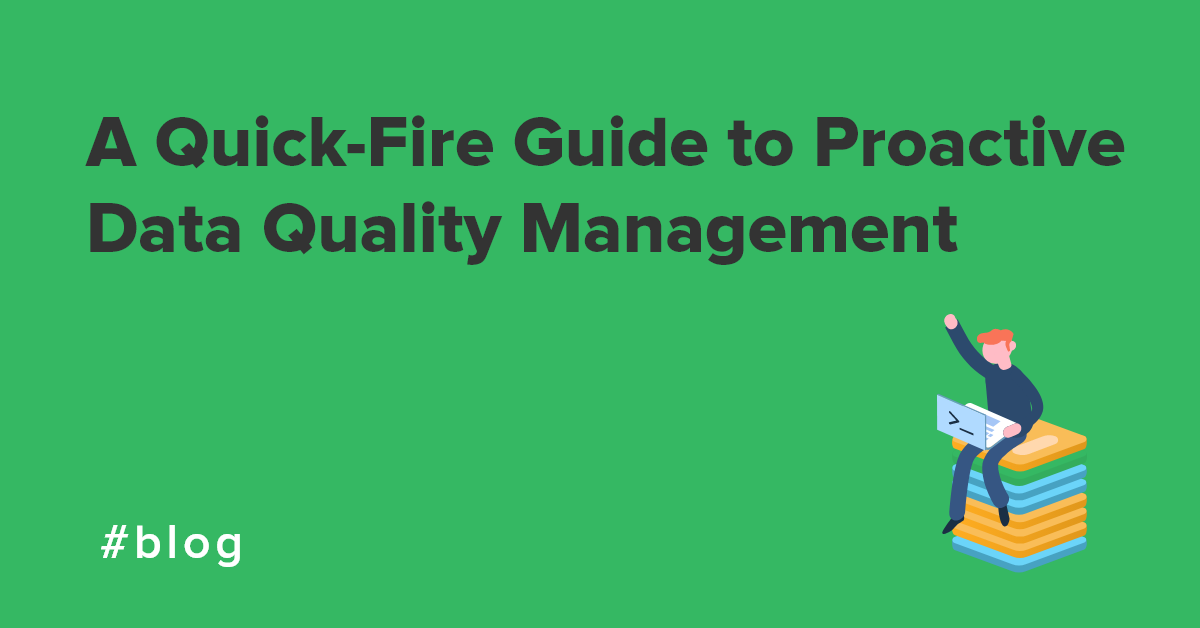Do you know what your customers want? Do you have the right information to deliver them the best possible service? Without powerful, timely and relevant data at your fingertips your financial firm will struggle to build the competitive edge it needs to deliver consistent and effective customer solutions.
Fortunately, that’s where proactive data quality management can make all the difference.
What is data quality management?
Data Quality Management is a set of practices that aim to maintain a high quality of information. This practice goes from the acquisition of data and understanding how to implement advanced data processes, to developing an effective distribution of data. In most cases, data quality management encompasses data acquisition, processing and distribution to produce actionable and accurate business insights.
Engaging in proactive DQM makes data quality a key part of your strategy. This reduces the risk of poorly informed decision-making and ensures the efficient functioning of your organisation.
So, let’s take a look at a few ways you can make this a reality.
Reactive vs Proactive data quality management
Now we’ve defined the intended concept of data quality management, let’s explore how this applies to the day-to-day world of financial services.
As you’ll know, today’s banking transactions are complex affairs. Data flows through your firm so fast it can be hard to keep up. If the data is accurate, consistent and timely, this doesn’t pose a problem.
However, slow or unresponsive data management can lead to major issues with quality and performance. For example, when carrying out bank reconciliations if you don’t have accurate, timely information you reduce your fraud detection capability.
In the past, human error was the chief cause of such data inadequacies, but, nowadays, automated solutions also play a big part.
Imagine one of your automated processes has an inconsistency or inaccuracy within it. The longer it runs, inaccuracy grows exponentially across your system. This is why proactive data quality management is important. If you are reactive, you are waiting for things to go wrong. With a proactive strategy, you can fix issues before they arise, preventing the proliferation of poor-data quality throughout your systems.

And there’s a cost advantage to this strategy too. Research shows that verifying data upon entry costs $1 and takes $10 to cleanse and deduplicate, while inaction ultimately costs $100 in lost time and productivity. Not only that but following data quality best practices can lead to a 66 percent revenue increase.
So, what do these best practices look like?
For now, let’s take a look at the four main ways your financial organization can achieve proactive data quality management.
1. Validate data at the start of every pipeline
Often, data originates from a single source before flowing into multiple systems. So checking its quality at the source is the best way to prevent low quality data from multiplying and spreading through your data pipelines. So before you allow your data to roam freely throughout your organisation give it a ‘sense check’.
This means checking everything is correctly formatted, de-duplicated and is relevant to your business strategy, as soon as it becomes a part of your core processes.
2. Validate data upon ingest
Automatically validating data when it arrives in your environment can be incredibly valuable to your firm. In fact, it saved our client $800,000 and increased marketing effectiveness by 12 percent.
Here are a few basic validation checks that can save you trouble down the line:
- Date validation. Make sure all dates are in a relevant format (e.g. dd/mm/yyyy). You can also approve future or past dates, depending on what information you want to gather.
- Value verification. You can create a list of accepted answers like country or state names or country phone codes. That way you only get information which is useful to you.
- Reasonable value. Ensure all form fields only accept relevant information. For example, don’t allow ‘n/a’ as a surname.
3. Carry out Data Quality Monitoring
You wouldn’t let a bull wander around a china shop unattended. And the same rules apply to your data. Even if you commit to validating data on input, you still need to monitor its integrity over time. This keeps your data healthy, relevant and actionable throughout its lifecycle.
But be sure to only monitor the data that drives your business decisions. If you cast your gaze too wide, you run the risk of information overload and may miss important data quality issues in mission-critical services.
To identify mission-critical data you need to prioritise information and then classify it. First you need to prioritise all information based on criteria such as:
- Impact on revenue and productivity
- Back-up recovery time
- Application performance and data retention
- Security requirements
Then you can classify such data as either:
- Vital. You would notice the data was missing almost immediately.
- Sensitive. It would take a few days for you to notice this data was missing.
- Non-critical. Even if you didn’t notice the information is missing the impact to your business would be minimal.
Focus on the data you would classify as either vital or sensitive. Anything else is not important enough to justify continued monitoring.
4. Ensure your reporting is timely and effective
Reporting on data migrations and integrations is rarely done well. You need to give stakeholders timely information so they can react quickly to any critical issues. The best reporting pipelines assign tasks, so everyone knows the next steps. Some common report examples are:
- Data quality reports
- Effort reports
- Resource utilization reports
When you deliver these reports, make sure they contain only relevant and actionable information. Don’t cover up the signal with too much noise. If business leaders can’t prioritise data quality actions, you will struggle to make the strategic changes you need to succeed.

Proactive data quality management leads to profitable decisions
For financial firms, a proactive data management strategy is vital to continued success. As a data manager, you know how important good data is to your business and the impact it can have on your bottom line. In many cases, without consistent and accurate information, you can even fall foul of financial auditing and compliance requirements, leading to unnecessary losses in revenue and reputation.
Fortunately, the right data tools and strategy can prevent you from ever ending up in this situation. To find out more about making proactive data management a core part of your organisation’s future, check out our complete guide to data quality and spark the change you need to thrive.
Read more: Data Quality with CloverDX











